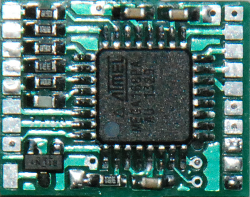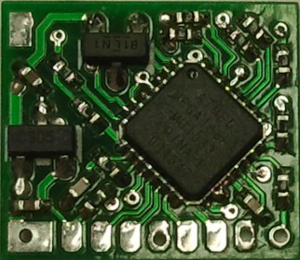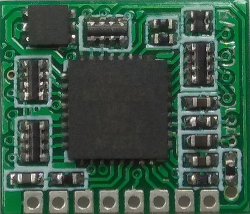General to the Cardecoder
|
|
The Cardecoder is the heart of every OpenCar-System vehicle. He is responsible for controlling
all components in the vehicle. It is now available in several generations which differ
significantly in size, functions. Versions 1 and 2 were available exclusively for
self-construction. From version 3, the cardecoder is available as a fully assembled board in the Fichtelbahn-Shop.
Here is an overview of the Cardecoder generations:
|

|
Cardecoder V1
First generation (2012), the control was carried out exclusively by infrared signal. This
version is in archive mode. |
 |
Cardecoder V2
Version 2 (2014) with stronger processor, control via infrared signal and radio possible.
Also V2 is no longer developed and is in archive mode. |
 |
Cardecoder V3
The third generation V3 (2014) is the first cardecoder to be ready in the Fichtelbahn-Shop. It is only suitable for operation with radio
control. This type of data transmission works even without line of sight to the vehicle. |

|
Cardecoder D2U (V4)
First vehicle specific version (2015), small hand-assembled series |

|
Cardecoder V5
Cardecoder V5 available in the Fichtelbahn-Shop
from QII / 2018, is an improved version of the V3. It has a current processor version, a
larger number of LED outputs and has integrated the external hardware enhancements of the
V3. |
|
Data of the Cardecoder:
| Operating voltage: |
Cardecoder V1-4: 2,4V to 4,2V (up 2 NiMh cells or 1 LiPo
cell)
Cardecoder V5: 2-5V (up 2 NiMh cells or 1 LiPo/LiFePO4 cell) |
| LED voltage: |
Cardecoder V1-4: 4,3V / 80 - 350 mA (depending on input voltage and decoder
version)
Cardecoder V5: 3,3V 100mA
|
| Motor control: |
to 500mA, load controlled by Cardecoder V3 and 5
|
| Battery monitoring: |
yes, programmable via CVs
|
| Distance control: |
yes, in two steps at approx. 15 cm and approx. 5 cm (can be switched off with F3)
|
| LED outputs: |
yes, with series resistor for: headlight, taillight, brake light, flashing light right +
left and 5 to 8 more freely programmable e.g. blue light
|
| Stop section: |
yes, input for original stop section (can be switched off with F4), recommendation IR stop
section
|
| Control: |
IR - DCC signal and from version V2.0.0 radio control |
| Programming: |
DCC - CV variables read and write in DCC service mode via IR - DCC signal
from version 3.0 POM CV read and write via radio signal
|
|
Features:
- Control via normal DCC digital signal
- Addressing with long and short DCC addresses (CV1 or CV17 / CV18)
- Motor control with 28 and 128 speed steps
- Front / tail light with FL (F0) switchable, brake light automatic
- Turn signal left / right switchable with F1 / F2
- Trailer control for lighting (with separate trailer decoder)
- 5 (up to 17) further LED outputs with effects freely programmable and switchable with F5-F12
- original stop section function integrated, can be switched off with F4
- Distance control to the vehicle ahead, with F3 off
- all LED outputs with integrated series resistors switching to GND
- Programmable battery monitoring
- Software update with bootloader via 2-wire connection possible
- Vehicle type programmable (e.g., bus, emergency vehicle, garbage truck, normal car ...)
different behavior of the vehicles due to the vehicle type possible
|
|
from software 03.xx.xx (05.xx.xx)
- Radio feedback of battery level in%, speed in km / h, position report
- Motor PID controller improved
- improved distance control
- improved twin stop section
- new decoder variant for controlling a sound module with 8 additional LED outputs
- CV list adapted to NRMA and DB decoder
from software 2.1.0
- Feedback of battery level in%, vehicle address, current vehicle driving level (change to
V2.0.0)
- 455kHz IR control removed
- changed distance control
- Decoder Voltage cutoff via stop section with F7 for break in operation
from software 2.0
- Write POM programming byte
- alternative control via 2.4 GHz radio signal / receiver possible (instead of the 455kHz IR
signal)
from software 1.2
- Feedback of battery level in%, vehicle address, current vehicle speed in cm / second and
vehicle type
- modulated IR signal crc8 secured
|





